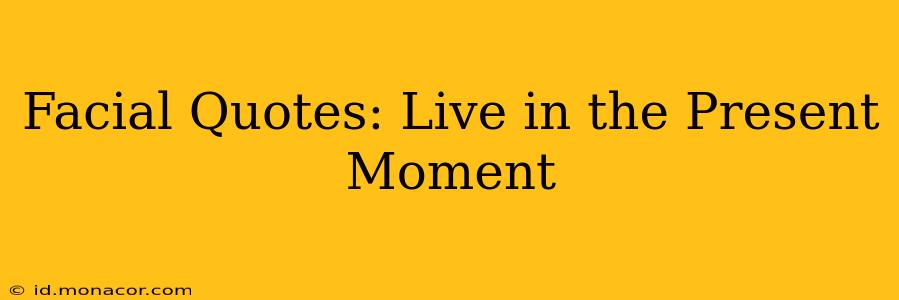Living in the present moment is a popular concept, often discussed in self-help circles and mindfulness practices. But how do we truly embody this idea? While profound philosophical treatises exist, sometimes a simple, evocative quote—especially one paired with a compelling facial expression—can capture the essence of present moment awareness more effectively than lengthy explanations. This article explores the power of facial expressions in conveying the feeling of being present, and delves into what "living in the present" truly means.
What Does it Mean to Live in the Present Moment?
Before we explore the visual representation, let's define what "living in the present moment" actually entails. It's not simply about being physically present; it's about a state of being fully engaged with your current experience, without dwelling on the past or anxiously anticipating the future. It's about focusing your attention on your breath, your senses, and your immediate surroundings. It's about accepting what is, without judgment. This mindful presence allows us to appreciate the richness and beauty of each moment, fostering a sense of peace and contentment.
How Facial Expressions Reflect Present Moment Awareness
The beauty of a facial expression conveying present moment awareness lies in its simplicity and authenticity. It's not about a forced smile or a contrived serenity. Instead, it's about the subtle nuances that reveal a state of inner peace and focus:
-
Soft Eyes: The eyes often hold the key. A person present in the moment may have a soft, gentle gaze, free from the tension or distraction often visible in someone preoccupied with thoughts.
-
Relaxed Brow: A furrowed brow signifies worry or stress, the antithesis of presence. A relaxed brow, on the other hand, suggests a calm and receptive state.
-
Slightly Open Mouth: A slightly parted mouth, not in a grimace or yawn, but a relaxed openness, can often indicate a person's receptiveness to their current experience.
-
Even Breathing: While not directly visible, the subtle cues of even breathing can reflect inner calmness and presence, impacting the overall facial expression.
-
Gentle Smile: A gentle, subtle smile, devoid of forced cheerfulness, can be a beautiful reflection of inner peace and contentment found in the present moment.
What are the Benefits of Living in the Present Moment?
This mindful approach offers numerous benefits:
-
Reduced Stress and Anxiety: By focusing on the present, we detach from the anxieties of the future and regrets of the past.
-
Increased Self-Awareness: Present moment awareness allows us to become more attuned to our emotions, thoughts, and physical sensations.
-
Enhanced Creativity and Productivity: When fully present, we are more receptive to new ideas and more focused on the task at hand.
-
Improved Relationships: By being fully present with others, we foster deeper connections and understanding.
-
Greater Appreciation for Life: By savoring each moment, we develop a greater sense of gratitude and appreciation for the richness of life.
How Can I Improve My Ability to Live in the Present Moment?
Cultivating present moment awareness takes practice. Here are some helpful techniques:
-
Mindfulness Meditation: Regular meditation helps train the mind to focus on the present.
-
Deep Breathing Exercises: Conscious breathing anchors us to the present moment.
-
Engaging the Senses: Pay attention to the details of your surroundings—sounds, smells, tastes, textures, sights.
-
Body Scan Meditation: Bring awareness to different parts of your body, noticing any sensations without judgment.
-
Mindful Activities: Engage in everyday activities with full attention – eating, walking, showering.
Are there Different Types of Present Moment Awareness?
While the core concept remains the same—focusing on the current experience—different mindfulness practices approach present moment awareness with varying perspectives. Some emphasize acceptance of all experiences, including challenging emotions, while others focus on cultivating positive emotions and appreciation. The key is to find a practice that resonates with you and supports your personal growth.
Can Facial Expressions be Used as a Tool for Mindfulness?
Absolutely! Paying attention to your own facial expression can be a powerful tool for mindfulness. Notice the tension in your jaw, the furrow in your brow, the tightness around your eyes. By consciously relaxing these muscles, you can invite a greater sense of calm and presence. Similarly, observing the facial expressions of others can offer insight into their emotional state and help you connect with them more deeply.
By understanding the significance of facial expressions in reflecting present moment awareness and actively practicing mindfulness techniques, we can all cultivate a richer, more fulfilling life lived fully in the present.

